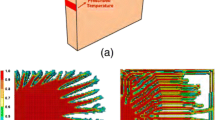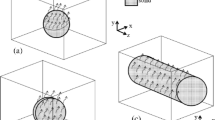Abstract
Topology optimization of simplified convective heat transfer has been widely studied, but most existing studies are based on the finite element method (FEM); methods based on the finite volume method (FVM) have been less studied. In this paper, a topology optimization method based on FVM was proposed for a simplified convective heat transfer problem. We developed a novel adjoint sensitivity analysis method applicable to FVM, which included adjoint equations, corresponding boundary conditions, and sensitivity analysis equations. Additionally, a program for the proposed topology optimization method was developed in open field operation and manipulation (OpenFOAM) and portable, extensibletoolkit for scientific computation (PETSc). Thus, large-scale topology optimizations could be performed in parallel. Furthermore, numerical examples of the classical two-dimensional (2D) and 3D optimization problems were considered. The results verified the effectiveness and feasibility of the proposed method. The results of large-scale 3D examples show an interesting phenomenon that for the optimized designs with few features, the large-scale topology optimization is still valuable for obtaining more effective structural shapes.
Similar content being viewed by others
References
Wang L, Xie Z H, Chen L G, et al. Equivalent thermal resistance minimization for a circular disc heat sink with reverting microchannels based on constructal theory and entransy theory. Sci China Tech Sci, 2021, 64: 111–121
Chen H, Li Q. Experimental study of a novel heat sink for distribution level static synchronous compensator cooling. Sci China Tech Sci, 2020, 63: 1764–1775
Cheng X T, Wang X Y, Liang X G. Role of viscous heating in entransy analyses of convective heat transfer. Sci China Tech Sci, 2020, 63: 2154–2162
Yan X H, Peng Y M, Shen Y T, et al. The use of phase-change cooling strategy in proton exchange membrane fuel cells: A numerical study. Sci China Tech Sci, 2021, 64: 2762–2770
Wang H, Guo L J, Chen K. Theoretical and experimental advances on heat transfer and flow characteristics of metal foams. Sci China Tech Sci, 2020, 63: 705–718
Bendsoe M P, Sigmund O. Topology Optimization: Theory, Methods, and Applications. Berlin: Springer Science & Business Media, 2003
Zhang K Q, Cheng G D, Wang Y. Structural topology optimization subject to overhang angle constraint with overhang length relaxation in additive manufacturing. Sci China Tech Sci, 2022, 65: 1213–1231
Lohan D J, Dede E M, Allison J T. A study on practical objectives and constraints for heat conduction topology optimization. Struct Multidisc Optim, 2020, 61: 475–489
Al Ali M, Shimoda M. Investigation of concurrent multiscale topology optimization for designing lightweight macrostructure with high thermal conductivity. Int J Thermal Sci, 2022, 179: 107653
Takezawa A, Yoon G H, Jeong S H, et al. Structural topology optimization with strength and heat conduction constraints. Comput Methods Appl Mech Eng, 2014, 276: 341–361
Lohan D J, Dede E M, Allison J T. Topology optimization for heat conduction using generative design algorithms. Struct Multidisc Optim, 2017, 55: 1063–1077
Borrvall T, Petersson J. Topology optimization of fluids in Stokes flow. Int J Numer Meth Fluids, 2003, 41: 77–107
Othmer C. A continuous adjoint formulation for the computation of topological and surface sensitivities ofducted flows. Int J Numer Meth Fluids, 2008, 58: 861–877
Evgrafov A. The limits of porous materials in the topology optimization of Stokes flows. Appl Math Optim, 2005, 52: 263–277
Kreissl S, Pingen G, Maute K. Topology optimization for unsteady flow. Int J Numer Meth Engng, 2011, 87: 1229–1253
Yaji K, Yamada T, Kubo S, et al. A topology optimization method for a coupled thermal-fluid problem using level set boundary expressions. Int J Heat Mass Transfer, 2015, 81: 878–888
Kontoleontos E A, Papoutsis-Kiachagias E M, Zymaris A S, et al. Adjoint-based constrained topology optimization for viscous flows, including heat transfer. Eng Optimiz, 2013, 45: 941–961
Li H, Ding X, Jing D, et al. Experimental and numerical investigation of liquid-cooled heat sinks designed by topology optimization. Int J Thermal Sci, 2019, 146: 106065
Liu J, Li R, Wang K. Net-based topology optimization approach for cooling channels. Int J Thermal Sci, 2020, 156: 106494
Hu D H, Zhang Z W, Li Q. Numerical study on flow and heat transfer characteristics of microchannel designed using topological optimizations method. Sci China Tech Sci, 2020, 63: 105–115
Qian S, Lou S, Ge C, et al. The influence of temperature dependent fluid properties on topology optimization of conjugate heat transfer. Int J Thermal Sci, 2022, 173: 107424
Yu M, Ruan S, Gu J, et al. Three-dimensional topology optimization of thermal-fluid-structural problems for cooling system design. Struct Multidisc Optim, 2020, 62: 3347–3366
Yoon G H. Topological design ofheat dissipating structure with forced convective heat transfer. J Mech Sci Technol, 2010, 24: 1225–1233
Yao Q Y, Zhao C Y, Zhao Y, et al. Topology optimization for heat transfer enhancement in latent heat storage. Int J Thermal Sci, 2021, 159: 106578
Cheng C H, Chen Y F. Topology optimization of heat conduction paths by a non-constrained volume-of-solid function method. Int J Thermal Sci, 2014, 78: 16–25
Zhao J, Zhang M, Zhu Y, et al. Topology optimization of planar cooling channels using a three-layer thermofluid model in fully developed laminar flow problems. Struct Multidisc Optim, 2021, 63: 2789–2809
Yu M, Ruan S, Wang X, et al. Topology optimization of thermal-fluid problem using the MMC-based approach. Struct Multidisc Optim, 2019, 60: 151–165
Pollini N, Sigmund O, Andreasen C S, et al. A “poor man’s” approach for high-resolution three-dimensional topology design for natural convection problems. Adv Eng Software, 2020, 140: 102736
Coffin P, Maute K. A level-set method for steady-state and transient natural convection problems. Struct Multidisc Optim, 2016, 53: 1047–1067
Alexandersen J, Sigmund O, Meyer K E, et al. Design of passive coolers for light-emitting diode lamps using topology optimisation. Int J Heat Mass Transfer, 2018, 122: 138–149
Lazarov B S, Sigmund O, Meyer K E, et al. Experimental validation of additively manufactured optimized shapes for passive cooling. Appl Energy, 2018, 226: 330–339
Alexandersen J, Sigmund O, Aage N. Large scale three-dimensional topology optimisation of heat sinks cooled by natural convection. Int J Heat Mass Transfer, 2016, 100: 876–891
Alexandersen J, Aage N, Andreasen C S, et al. Topology optimisation for natural convection problems. Int J Numer Meth Fluids, 2014, 76: 699–721
Zhou M, Alexandersen J, Sigmund O, et al. Industrial application of topology optimization for combined conductive and convective heat transfer problems. Struct Multidisc Optim, 2016, 54: 1045–1060
Yoon M, Koo B. Topology design optimization of conductive thermal problems subject to design-dependent load using density gradients. Adv Mech Eng, 2019, 11: 168781401985073
Wang C, Qian X. A density gradient approach to topology optimization under design-dependent boundary loading. J Comput Phys, 2020, 411: 109398
Yan X Y, Liang Y, Cheng G D. Discrete variable topology optimization for simplified convective heat transfer via sequential approximate integer programming with trust-region. Numer Meth Eng, 2021, 122: 5844–5872
Gersborg-Hansen A, Bendsøe M P, Sigmund O. Topology optimization of heat conduction problems using the finite volume method. Struct Multidisc Optim, 2006, 31: 251–259
Lazarov B S, Sigmund O. Filters in topology optimization based on Helmholtz-type differential equations. Int J Numer Meth Engng, 2011, 86: 765–781
Wang F, Lazarov B S, Sigmund O. On projection methods, convergence and robust formulations in topology optimization. Struct Multidisc Optim, 2011, 43: 767–784
Sigmund O. Morphology-based black and white filters for topology optimization. Struct Multidisc Optim, 2007, 33: 401–424
Darwish M, Moukalled F. The Finite Volume Method in Computational Fluid Dynamics: An Advanced Introduction with OpenFOAM® and Matlab®. Cham: Springer, 2021
Aage N, Andreassen E, Lazarov B S. Topology optimization using PETSc: An easy-to-use, fully parallel, open source topology optimization framework. Struct Multidisc Optim, 2015, 51: 565–572
Author information
Authors and Affiliations
Corresponding author
Additional information
This work was supported by the Aeronautical Science Foundation of China (Grant No. 2020Z009063001) and the Fundamental Research Funds for the Central Universities (Grant No. DUT22GF303).
Rights and permissions
About this article
Cite this article
Yan, K., Wang, Y., Pan, Y. et al. Topology optimization of simplified convective heat transfer problems using the finite volume method. Sci. China Technol. Sci. 66, 1352–1364 (2023). https://doi.org/10.1007/s11431-022-2198-4
Received:
Accepted:
Published:
Issue Date:
DOI: https://doi.org/10.1007/s11431-022-2198-4




